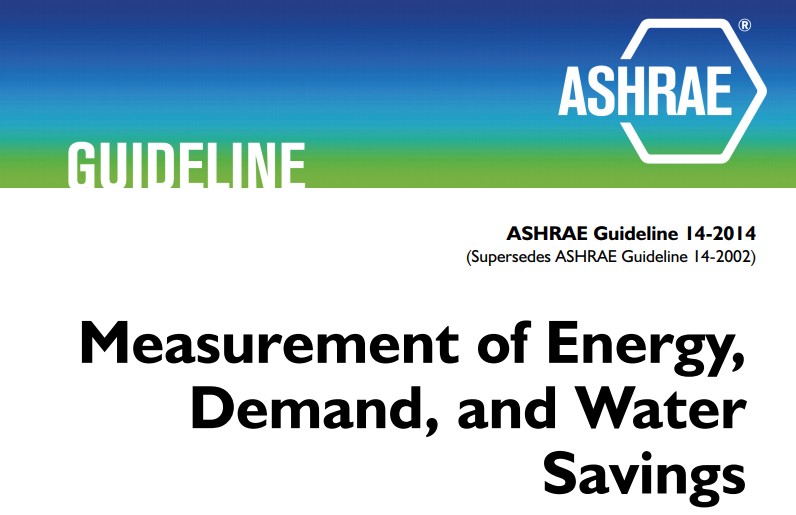Quantifying the savings of energy efficiency projects is increasingly important as the technology and industry continue to advance, which is why M&V has become the industry standard. To help standardize the calculation processes, ASHRAE developed Guideline 14-2014, Measurement of Energy, Demand, and Water Savings. Its primary purpose is to “provide guidelines for reliably measuring the energy, demand, and water savings achieved in conservation projects.” To determine the savings in accordance with the guideline, measurements of post-retrofit energy use are compared to pre-retrofit use and adjusted to show a representation of the conditions had the retrofit not been implemented. ASHRAE Guideline 14 creates specific procedures for using measured pre-retrofit and post-retrofit billing data (kWh, kW, etc.) for the calculation of savings. The ASHRAE Guideline 14-2014 procedures include: the determination of energy, demand, and water savings from individual facilities or meters, applies to all forms of energy (including electricity, gas, oil, district heating/cooling, renewables, and water), and encompasses all types of facilities (commercial, industrial, and residential).
ASHRAE Guideline 14-2014 Approaches:
ASHRAE Guideline 14-2014 provides three different engineering approaches to M&V and savings determination. To ensure validity, reaching compliance with each approach requires that the overall uncertainty of the savings estimates is below the prescribed thresholds. The three approaches to determining savings use similar concepts in computing savings, but differ in how they measure energy use and demand quantities. Their approaches are:
- Retrofit Isolation Approach – Measures the energy use and relevant independent variables of the individual systems and equipment actually affected by the retrofit. Baseline and post-installation measurements are required and for a specific duration that will illustrate the full range of impact.
- Whole Facility Approach – Uses the measured energy use of the building or an entire facility to determine savings. This approach requires the collection of utility meter or specific submetered data and independent variables such as weather.
- Whole Building Calibrated Simulation Approach – Involves the use of a computer simulation tool to create a model of energy use and demand of the building. This approach is typically used in pre-retrofit analysis and uses actual measurements of energy usage and demand to project post-retrofit conditions.
How ASHRAE Guideline 14 differs from IPMVP:
Although a slightly different design than IPMVP, the two guidelines act as complements to each other. ASHRAE Guideline 14 solely covers identifying and measuring energy and demand to determine savings. It does not detail other elements in an energy performance contract such as the determination of appropriate utility rates, equipment installation, etc. However, IPMVP helps to develop the standard framework for M&V projects that ASHRAE Guideline 14 follows through its outlined approaches. ASHRAE Guideline 14 also provides metrics to evaluate the validity of M&V models, such as specific thresholds for net determination bias and maximum savings uncertainty, while IPMVP does not.
Benefits of ASHRAE:
Overall, ASHRAE Guideline 14 helps to simplify the M&V process by providing specific procedures and calculation thresholds for its users. It provides reliability to energy efficiency projects and reduces the struggle that often comes when implementing an M&V analysis. By offering guidelines to specific approaches, it also eases the reporting of progress and achievements post-retrofit.
The implementation of an energy efficiency project is just the beginning. An ASHRAE Guideline 14-2014 compliant M&V process is the next step to ensuring savings and project effectiveness. In order to do so, integrating data streams such as weather variables and interval data in a unified energy management platform is crucial. Learn more about watchwire , where meter, weather, occupancy (and any other trackable independent variable), and invoice information is fully integrated and M&V performance is accessible via the cloud to all interested parties.
Sources:
ASHRAE Guideline 14-2014: Measurement of Energy, Demand, and Water Savings. ASHRAE. December 18, 2014.
 Top Sustainability Trends to Watch in 2025
Top Sustainability Trends to Watch in 2025

 Log In
Log In








